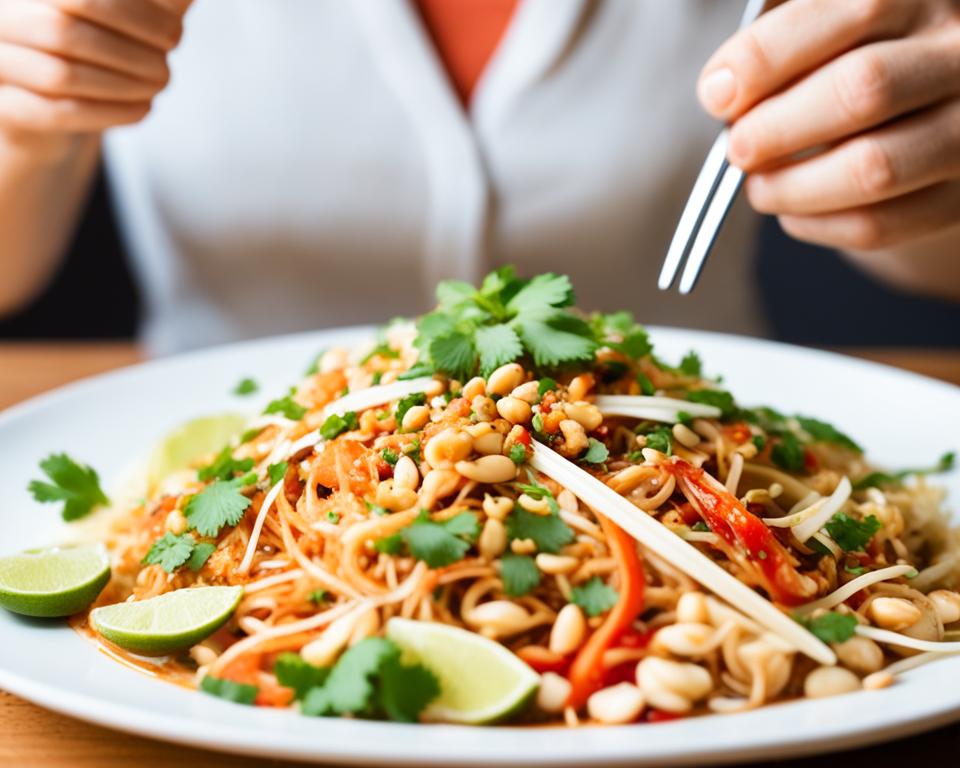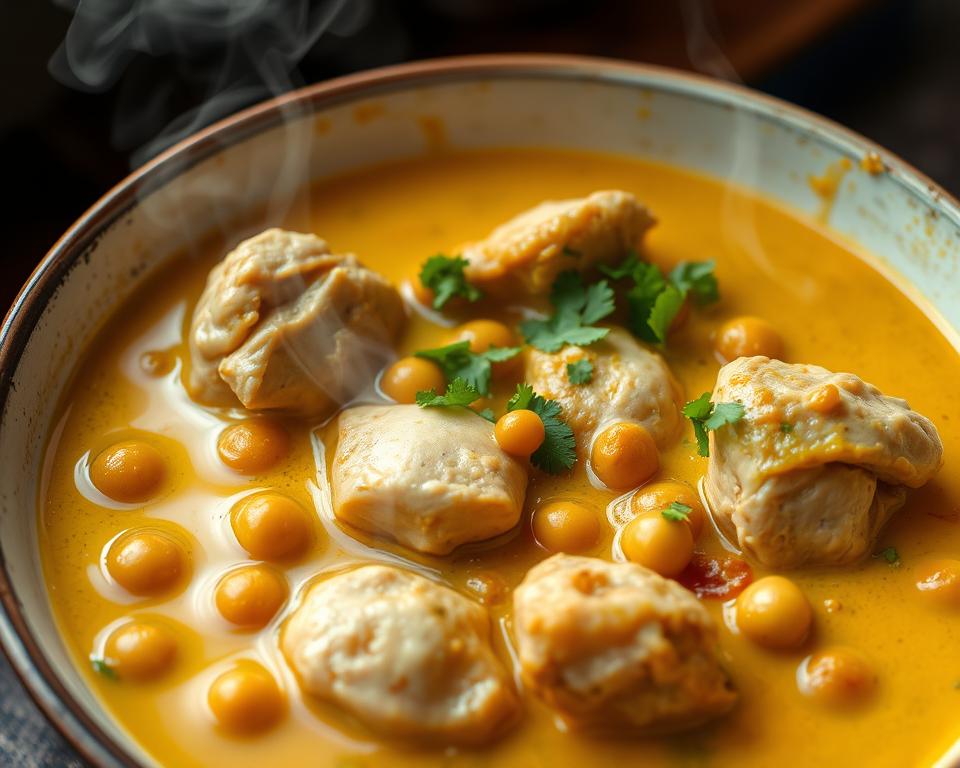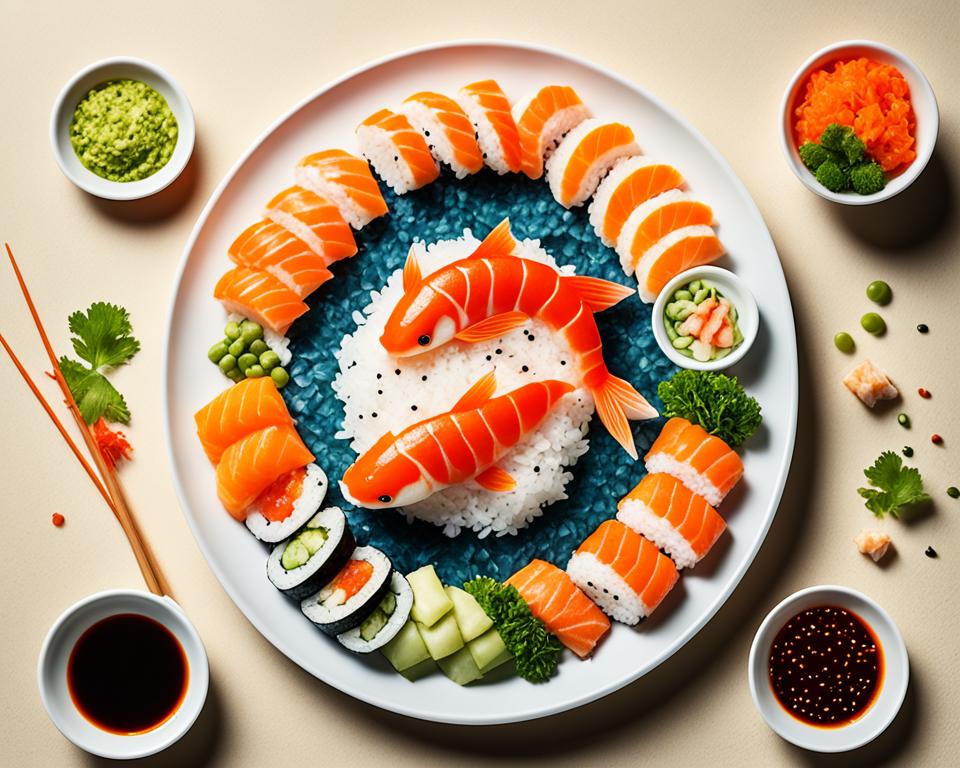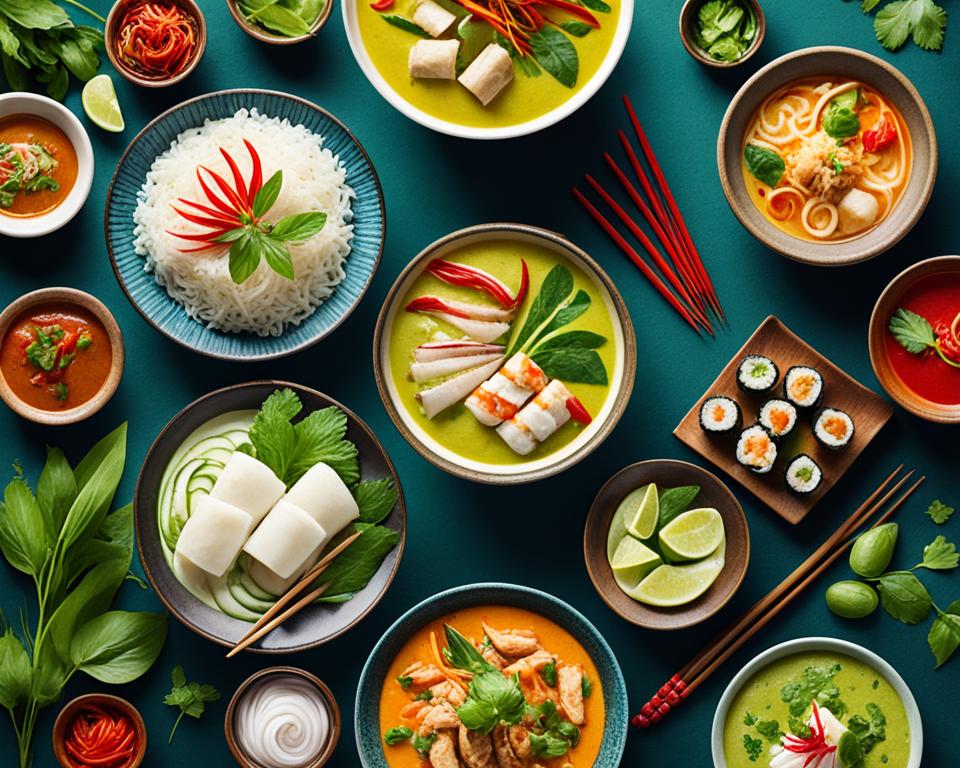Want the taste of Thailand’s famous pad thai but at home? This guide has your back. We’ll help you bring the true flavor of pad thai to your dinner table. Pad thai is a favorite worldwide, mixing rice noodles, meat, veggies, and a special sauce. You can make it easily with a few ingredients and tips, getting those sweet and savory Thai flavors just right.
This article dives into what pad thai is, its unique ingredients, the tools you need, and a recipe to follow. It’s perfect for anyone, whether you cook a lot or a little. Your pad thai will taste like it’s from a Thai street market. Get set to wow your loved ones with your authentic Thai cooking!
Read more interesting information at ::mbp-ehime
What is Pad Thai?
Pad Thai is a famous Thai noodle dish that people love worldwide. It mixes rice noodles, protein, veggies, and a sweet-savory sauce well. This mix of flavors delights everyone who tries it.
Popularity of Thai Cuisine
In recent years, Thai food has become very popular all over the globe. From the busy streets of Bangkok to top-notch dining spots, Thai food stands out. Pad Thai, especially, is adored by many and is known worldwide as a favorite Thai dish.
Origins of Pad Thai Noodles
The story of Pad Thai dates back to the 1930s, when Thailand promoted it as a national gem. It was part of the government’s effort to showcase the richness of Thai cuisine. They wanted to boost the use of local ingredients, which greatly lifted Pad Thai’s status.
“Pad Thai is a harmonious symphony of flavors, with each ingredient playing a vital role in creating the perfect balance of sweet, sour, salty, and umami.”
Now, Pad Thai can be found all over the world, from Thai eateries to home kitchens. It shows the true essence of Thai food – a blend of various flavors that harmonize perfectly.
Classic Pad Thai Ingredients
To make a real pad thai recipe, you need to pick the right ingredients. They all come together to give that sweet, sour, and savory taste we love in this Thai dish. From the chewy rice noodles to the salty fish sauce, everything counts. They help make a true homemade pad thai taste amazing.
A key part of a classic pad thai is the meat or no meat choice. You can go with juicy shrimp, soft chicken, or tofu if you’re vegetarian. It’s all topped with a sauce that includes tangy tamarind, sweet palm sugar, and fish sauce for that real Thai flavor.
Don’t forget the crunchy bean sprouts, crushed peanuts, and herbs like cilantro and Thai basil. They give the dish texture, variety, and a hint of something fresh. Together, these pad thai recipe ingredients make your taste buds feel like you’re in Thailand.
| Ingredient | Purpose |
|---|---|
| Rice Noodles | Provides the base and chewy texture |
| Protein (Shrimp, Chicken, or Tofu) | Adds substance and a source of protein |
| Tamarind | Imparts the signature tangy flavor |
| Fish Sauce | Contributes the umami notes |
| Palm Sugar | Balances the flavors with sweetness |
| Bean Sprouts | Provides a crunchy texture |
| Crushed Peanuts | Adds a nutty element and crunch |
| Fresh Herbs (Cilantro, Thai Basil) | Infuses the dish with fragrant, fresh flavors |
To cook great pad thai at home, choose and mix these ingredients with care. This way, you can enjoy the rich, real flavors of this favorite Thai dish wherever you are.
Tools Needed for Homemade Pad Thai
To make an authentic homemade pad thai, you need a few key kitchen items. These tools are essential for a great pad thai at home.
Essential Kitchen Utensils
The essential tools for a homemade vegetarian pad thai are:
- A wok or large skillet: This pan is perfect for stir-frying over high heat.
- Tongs: Use tongs to mix the noodles and other pad thai parts.
- A spatula: This helps turn and cook the pad thai evenly.
- A cutting board and sharp knife: These make chopping veggies and other things easy.
With these tools, you’re set to make pad thai that’s as good as your favorite Thai spot. Having the right gear makes cooking pad thai fun and easy at home.
| Kitchen Tool | Purpose |
|---|---|
| Wok or Large Skillet | Stir-frying the pad thai ingredients over high heat |
| Tongs | Grasping and tossing the noodles and other components |
| Spatula | Flipping and turning the pad thai as it cooks |
| Cutting Board and Sharp Knife | Chopping the vegetables and other ingredients |
“Having the right tools makes all the difference in creating an authentic homemade pad thai that captures the essence of Thai cuisine.”
Getting these key tools for your kitchen helps you perfect pad thai at home. The correct equipment means you’ll easily cook tasty pad thai and enjoy Thai flavors at home.
Step-by-Step Pad Thai Recipe
Making homemade pad thai is a fun and rewarding process. This dish is loved all over Thailand. By using this recipe, you’ll be able to make a tasty pad thai at home. Your family and friends will be impressed with the delicious flavors you create.
Preparing the Noodles
The key to great pad thai is the noodles. Soak the rice noodles in hot water for 30 minutes. They should be soft but firm.
After soaking, drain the noodles and rinse with cold water. They’ll be perfectly hydrated and ready to take in the meal’s flavors.
Cooking the Proteins
- If using shrimp, peel them and devein them. Keep the tails on for a nice look.
- Slice chicken breasts into small, thin pieces if using.
- Use a wok or a large skillet over high heat. Cook the proteins with a bit of oil until they are done and slightly brown. Then, take them out and set aside.
Assembling the Pad Thai
Using the same wok or skillet, heat a little more oil. Add the noodles and stir-fry for a couple of minutes.
Then, toss in the cooked proteins, bean sprouts, green onions, peanuts, and the pad thai sauce. Mix everything well. Make sure the noodles are coated and the flavors mix together.
| Ingredient | Quantity |
|---|---|
| Rice noodles | 8 oz (225g) |
| Shrimp or chicken | 1 lb (450g) |
| Bean sprouts | 1 cup (100g) |
| Green onions, chopped | 1/2 cup (50g) |
| Crushed peanuts | 1/4 cup (35g) |
| Pad thai sauce | 1/2 cup (120ml) |
By following these easy steps, you can make a homemade pad thai that’s just as good as what you find in authentic Thai restaurants. Share your dish with loved ones and enjoy Thailand’s flavors in your home.
Vegetarian and Vegan Pad Thai Options
If you’re into pad thai but want a version without meat, you’re in luck. There are many delicious options for vegetarians and vegans. You can have a tasty meal that fits your diet goals.
Making a vegetarian pad thai is simple. Just swap out the meat for tofu or a mix of veggies. Marinate the tofu and stir-fry it with the noodles. This way, you still get plenty of protein. Add in some mushrooms, peppers, or broccoli for more flavor.
For vegan pad thai, go a step further by cutting out all animal products. Skip the eggs and use plant-based alternatives for the fish sauce. You can still get that classic pad thai taste with soy sauce, lime juice, and a bit of sweetener. Scrambled tofu makes a great egg substitute.
| Ingredient | Vegetarian Pad Thai | Vegan Pad Thai |
|---|---|---|
| Protein | Tofu, sautéed vegetables | Tofu, sautéed vegetables |
| Eggs | Scrambled tofu | Scrambled tofu |
| Fish Sauce | Vegetarian fish sauce alternative | Soy sauce, lime juice, sweetener |
Exploring vegetarian pad thai and vegan pad thai dishes lets you enjoy this Thai favorite. You can play with various plant-based ingredients to match your preferred tastes. Plus, it’s a great way to meet your dietary needs.
Gluten-Free Pad Thai at Home
Wish you could make your pad thai gluten-free? You can, and it’s tasty and true to the dish’s origins. Just switch to rice noodles and make sure all your sauces are wheat-free. Then, you can delight in gluten-free pad thai right at home.
Focus on choosing the right ingredients for your homemade pad thai. Use rice noodles instead of the usual noodles. It’s always smart to check that sauces and condiments are marked ‘gluten-free’.
Gluten-Free Pad Thai Ingredients
- Rice noodles
- Gluten-free fish sauce
- Gluten-free soy sauce or tamari
- Rice vinegar
- Brown sugar
- Lime juice
- Eggs
- Protein of your choice (such as shrimp, chicken, or tofu)
- Bean sprouts
- Crushed peanuts
- Chopped cilantro
With these ingredients, your gluten-free pad thai will mimic the popular dish expertly. It’s nourishing and great for anyone with gluten concerns.
“Pad thai is one of the most popular Thai dishes, and it’s surprisingly easy to make a gluten-free version at home. With the right ingredients, you can enjoy all the flavors without the gluten.”
Making gluten-free pad thai lets you pick the best and freshest ingredients. This means a healthier and tastier meal. Whether for a gluten-free diet or to explore Thai food, this recipe is perfect for any kitchen.
Pad Thai at Home for Busy Weeknights
Pad thai is great for when you’re busy. It’s a tasty Thai noodle dish you can make at home fast. If you keep some key ingredients around, you won’t need much time to cook it.
Meal Prep Made Easy
Getting pad thai ready for dinner is easier with some prep. Chop up your veggies like bean sprouts and carrots early. Cook the noodles and keep them in the fridge. A little oil stops them from sticking.
Customize Your Pad Thai
Homemade pad thai lets you play with flavors. You can choose if you want shrimp, chicken, or tofu in it. Mix up the sweet, sour, and spicy tastes how you like. Feel free to get creative.
“Pad Thai is the perfect solution for busy weeknights when you crave a delicious, authentic Thai meal.”
Time-Saving Tips
- Prep ingredients in advance to reduce active cooking time.
- Use pre-cooked or fresh rice noodles for quicker preparation.
- Opt for a wok or large skillet to cook the dish efficiently.
- Employ the help of a family member or friend to speed up the assembly process.
Following these tips will let you have tasty pad thai on any night. Enjoy the convenience of making it at home. It’s a fun way to enjoy Thai noodles without the stress.
Authentic Thai Flavors in Every Bite
Creating Thai cuisine at home starts with a mix of sweet, sour, salty, and spicy tastes. The key to a delicious pad thai is combining tamarind, fish sauce, and palm sugar. This mix gives this Thai food its famous flavor.
Tamarind is a key fruit in making pad thai taste real. It’s sour and a bit sweet, making the dish not too rich. Then, there’s fish sauce. It brings a unique, savory taste that’s a must in Thai dishes. Palm sugar tops it off by adding sweetness without being overpowering.
Along with these, using fresh cilantro, Thai basil, great noodles, and protein is vital. These parts ensure each bite tastes like it was made in Thailand.
| Key Ingredient | Role in Authentic Pad Thai |
|---|---|
| Tamarind | Provides a tangy, slightly sweet flavor that balances the richness of the dish |
| Fish Sauce | Adds a savory, umami depth that is essential to Thai cuisine |
| Palm Sugar | Gives the dish its characteristic caramelized sweetness |
By getting these flavors right, anyone can make top-notch pad thai at home. The goal is to mimic the great taste of Thai food delivery. You want your dish to feel like a quick trip to Thailand with every bite.
Pad Thai at Home: A Healthier Choice
Homemade pad thai gives you a better option than ordering out or eating it at a restaurant. Making pad thai at home means you pick the ingredients. This way, it fits your dietary needs. You can make it healthier, whether you prefer vegetarian pad thai or want to cut some calories.
Choosing the right protein is key in making homemade pad thai healthier. Instead of high-fat options like fried tofu or shrimp, go for lean proteins. Try grilled chicken, shrimp, or plant-based choices, like firm tofu or tempeh. These are lower in fat and calories but still give you protein.
Adding more veggies can also boost the healthiness of your home-cooked pad thai. Use less noodles and more fresh vegetables. Think bean sprouts, carrots, bell peppers, and snow peas. This adds nutrition, color, and a nice crunch to your meal.
| Ingredient | Healthier Option | Conventional Option |
|---|---|---|
| Protein | Grilled chicken, shrimp, or plant-based options | Fried tofu or shrimp |
| Noodles | Whole wheat or brown rice noodles | White rice noodles |
| Oil | Sesame oil or reduced-sodium soy sauce | Vegetable or peanut oil |
| Sugar | Natural sweeteners like honey or maple syrup | Granulated sugar |
Simple changes can keep pad thai healthy without losing its true taste. Try whole wheat or brown rice noodles. Use sesame oil or reduced-sodium soy sauce. Sweeten with honey or maple syrup instead of regular sugar. These swaps will improve the nutrition of your dish.
Making pad thai in your kitchen lets you make it just right for you. You get to enjoy the great taste of this Thai favorite while choosing healthier options. With some creativity and smart ingredient choices, you can have a great vegetarian pad thai or a lighter take on this tasty dish at home.
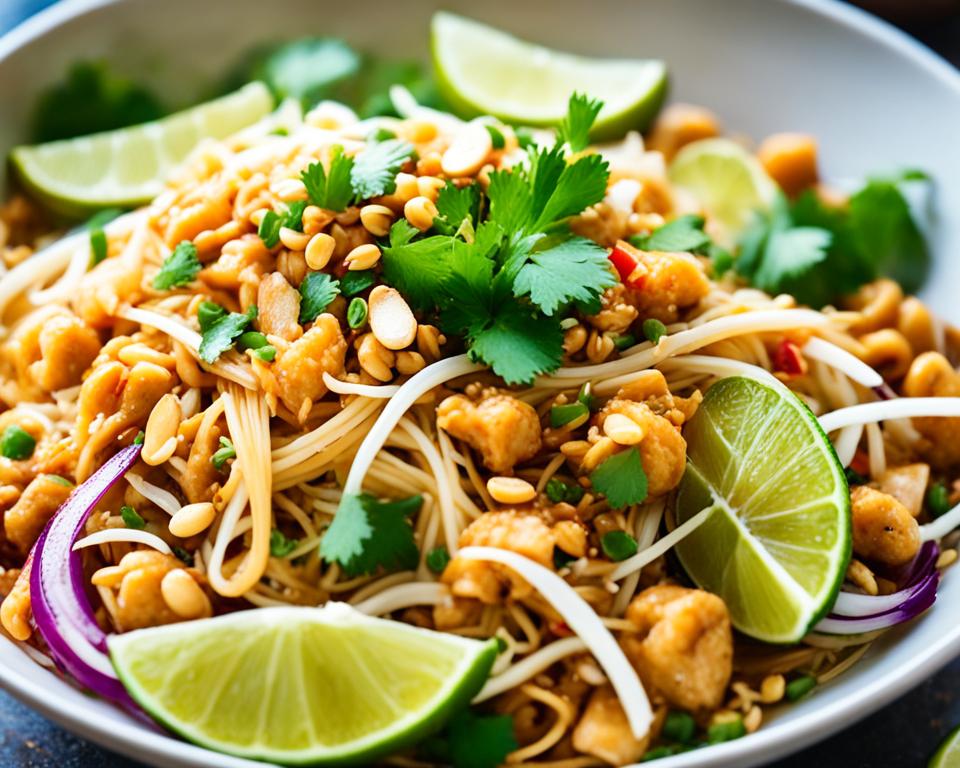
Customize Your Pad Thai to Taste
Making your own pad thai means you can add your favorite flavors. This Thai noodle dish lets you get creative. You can add more spice, different meats, or lots of veggies. The possibilities for your pad thai recipe are limitless.
Popular Pad Thai Variations
Most people start with a basic pad thai recipe. But, it’s fun to make it your own. Here are some ideas to change it up:
- Spicy Pad Thai: Want more heat? Add some chili peppers or a bit of sriracha or chili-garlic sauce.
- Protein-Packed Pad Thai: Use shrimp, chicken, tofu, or a mix to get your protein your way.
- Veggie-Loaded Pad Thai: Add plenty of fresh vegetables. Think bean sprouts, carrots, peppers, or broccoli.
- Nutty Pad Thai: Top it off with some crushed peanuts or cashews for a nice crunch.
- Pad Thai with Eggs: Throw in a fried or scrambled egg for extra protein and texture.
To make the best homemade pad thai, try different ingredients and tastes. Mix and match until you love what you’re eating. Don’t hesitate to get playful and put your own spin on it.
“The beauty of pad thai is that it’s a blank canvas for your culinary creativity. Embrace the freedom to customize and make it your own.”
Whether you like it spicy or more laid-back, there are many ways to make your pad thai unique. Enjoy the process of creating your special pad thai recipe.
Storing and Reheating Leftover Pad Thai
Homemade pad thai tastes best when it’s first made. But, you can still enjoy the leftovers. Just store them right and reheat them well. This way, your leftover pad thai at home keeps its Thai flavors and great texture, even after it’s been in the fridge or freezer.
Proper Storage for Leftover Pad Thai
To keep the quality of your leftover thai noodle dishes, use these tips for storing:
- Let the pad thai cool down completely first.
- Put the noodles and toppings in an airtight container or zip-top bag.
- Keep them in the fridge and eat them within 3-4 days for the best taste.
- For later, freeze the leftover pad thai in a freezer-safe container for up to 2 months.
Reheating Leftover Pad Thai
Ready to enjoy your leftover homemade pad thai? Here’s how to reheat it:
- For leftovers from the fridge, just heat them in a skillet or wok over medium. Stir occasionally until they’re warm.
- If the noodles are dry, add a little water or stock to the pan to make them moist again.
- For frozen leftovers, let the pad thai thaw in the fridge overnight first.
- After thawing, reheat the noodles in a skillet or wok. Add water or stock as needed to keep them from drying out.
Follow these steps for storing and reheating. This way, you’ll get to enjoy more of your pad thai. Eat every bite of your tasty Thai dish, fresh or as a yummy leftover.
The Best Pad Thai at Home
You can make the best pad thai at home. Just follow our guide carefully. It shows you how to get that pad thai taste at home. You need good ingredients and to balance sweet, sour, salty, and umami tastes well. This is what makes pad thai so popular.
The noodle is the heart of great pad thai. Choose the right pad thai noodles for a perfect dish. Mix them with shrimp or chicken, bean sprouts, peanuts, and sauce. These ingredients work together for the tasty pad thai you love.
To make pad thai at home taste like a restaurant, cooking matters a lot. Cook the noodles and meat well. Then, mix them with the right flavors for a great dish. Practice and soon, you’ll make Thai food delivery quality pad thai.
| Key Factors for the Best Homemade Pad Thai | Tips |
|---|---|
| Quality of Ingredients | Use high-quality pad thai noodles, fresh proteins, and authentic Thai condiments. |
| Cooking Technique | Properly prepare the noodles, proteins, and other ingredients, and assemble the dish with care. |
| Flavor Balance | Achieve the perfect balance of sweet, sour, salty, and umami flavors for an authentic taste. |
Remember these tips for a top-notch pad thai at home. Creating one that’s like what you get at great Thai spots is doable. Enjoy your homemade pad thai and the joy of making it at home.
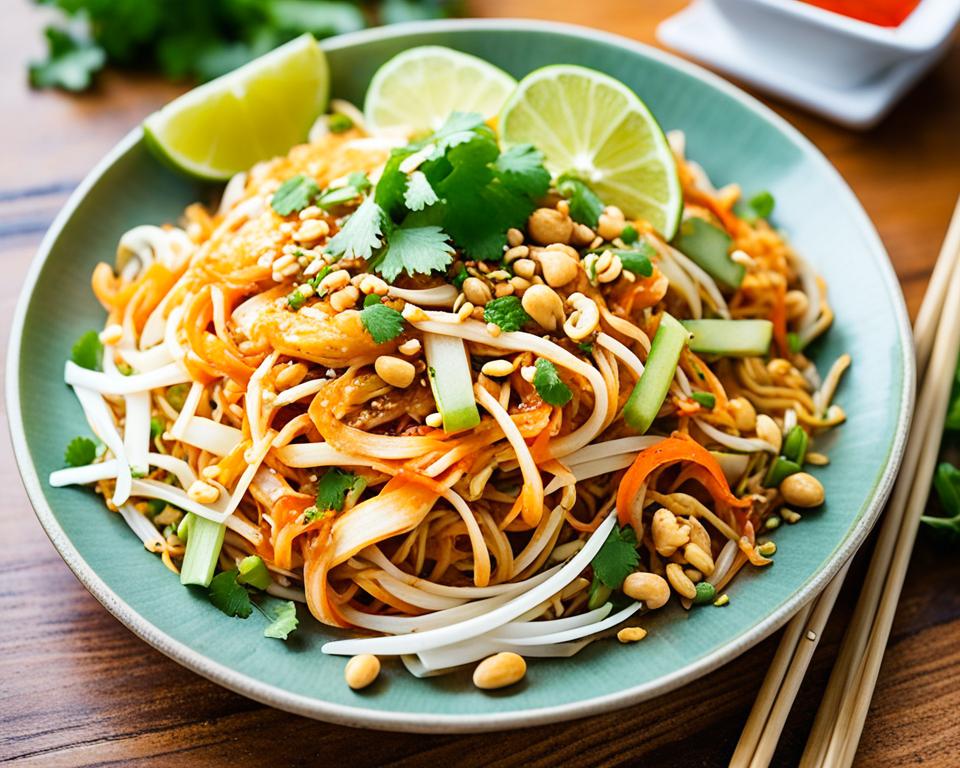
Conclusion
In closing, whipping up real pad thai at home can be easy and fulfilling. You just need the right ingredients, tools, and tricks. Then, you can get those bold Thai flavors at your own kitchen table. This piece has shared all you need to know to mirror Thailand’s favorite thai noodle dishes.
It doesn’t matter if you’re a pro chef or just starting out. Our guide and options here are for everyone. You’ll learn how to make the noodles just right. Plus, you’ll nail the mix of sweet, sour, and salty flavors. This way, you can have a real Thai dining experience in your place.
Enjoy the thrill of making this famous dish yourself. And relish the moment when you serve up pad thai at home that tastes like it’s from a top restaurant. Now, you’re set to dive deep into Thai food and expand your cooking horizons. Prepare to wow your loved ones with your homemade pad thai and enjoy their happy reactions.
